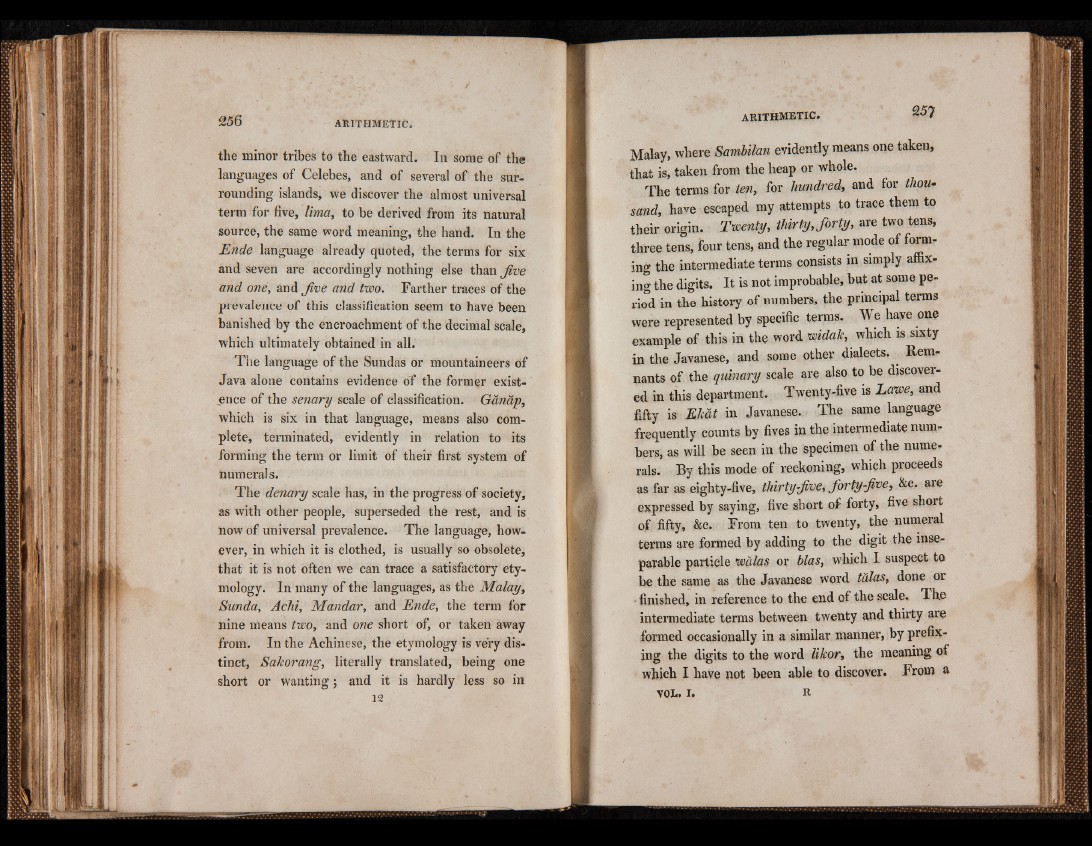
the minor tribes to the eastward. In some of the
languages of Celebes, and of several of the surrounding
islands, we discover the almost universal
term for five, lima, to be derived from its natural
source, the same word meaning, the hand. In the
Ende language already quoted, the terms for six
and seven are accordingly nothing else than jive
and one, and jive and two. Farther traces of the
prevalence of this classification seem to have been
banished by the encroachment of the decimal scale,
which ultimately obtained in all.
The language of the Sundas or mountaineers of
Java alone contains evidence oT the former existence
of the senary scale of classification. Gânâp,
which is six in that language, means also complete,
terminated, evidently in relation to its
forming the term or limit of their first system of
numerals.
The denary scale has, in the progress of society,
as with other people, superseded the rest, and is
now of universal prevalence. The language, however,
in which it is clothed, is usually so obsolete,
that it is not often we can trace a satisfactory etymology.
In many of the languages, as the Malay,
Sunda, Achi, Mandar, and Ende, the term for
nine means two, and one short of, or taken away
from. In the Achinese, the etymology is very distinct,
Sakorang, literally translated, being one
short or wanting ; and it is hardly less so in
12
Malay, where Sambilan evidently means one taken,
that is, taken from the heap or whole.
The terms for ten, for hundred, and for thousand,
have escaped my attempts to trace them to
their origin. Twenty, thirty, forty, are two tens,
three tens, four tens, and the regular mode of forming
the intermediate terms consists in simply affixing
the digits. It is not improbable, but at some period
in the history of numbers, the principal terms
were represented by specific terms. We haye one
example of this in the word widak, which is sixty
in the Javanese, and some other dialects. Remnants
of the quinary scale are also to be discovered
in this department. Twenty-five is Lawe, and
fifty is Ekat in Javanese. The same language
frequently counts by fives in the intermediate numbers,
as will be seen in the specimen of the numerals.
By this mode of reckoning, which proceeds
as far as eighty-five, thirty jive, forty jive, &c. are
expressed by saying, five short of forty, five short
of fifty, &c. From ten to twenty, the numeral
terms are formed by adding to the digit the inseparable
particle wálas or bias, which I suspect to
be the same as the Javanese word talas, done or
finished, in reference to the end of the scale. The
intermediate terms between twenty and thirty are
formed occasionally in a similar manner, by prefixing
the digits to the word likor, the meaning of
which I have not been able to discover. From a
v o l . 1. R